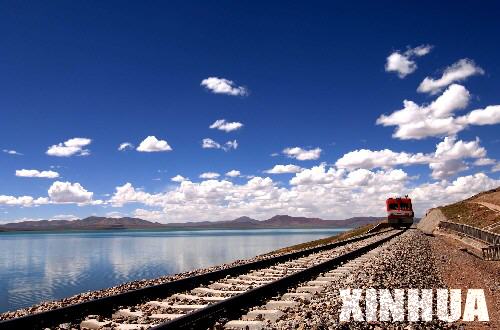Swelling lakes in Hol Xil pose railway threat
 0 Comment(s)
0 Comment(s) Print
Print E-mail Xinhua, October 22, 2013
E-mail Xinhua, October 22, 2013
Swelling lakes on the Qinghai-Tibet Plateau, a notable sign of global warming, are threatening the safety of the world's highest railway, according to climate and ecological experts.
|
|
|
Swelling lakes on the Qinghai-Tibet Plateau are threatening the safety of the world's highest railway. [Xinhua] |
One flooded lake is now only 8 km away from a section of the Qinghai-Tibet Railway in the depopulated area of Hol Xil Nature Reserve, according to the latest satellite monitoring by the Qinghai Provincial Academy of Meteorological Sciences.
Liu Baokang, engineer with the academy's remote-sensing and ecological evaluation center, said several lakes in the nature reserve have been overflowing since 2011 after receiving an increasing volume of melted snow from glaciers on the plateau, known as the "roof of the world."
Liu said the center's research shows that the lakes have become a threat to the railway's roadbed and roads on the Qinghai-Tibet Highway as well as important oil pipelines, cables and power facilities that run through the region.
Sitting 4,600 meters above sea level, the 45,000 square km Hol Xil nature reserve is China's largest unpopulated area and is home to wild yaks and endangered Tibetan antelope.
Major lakes in the reserve, namely Zhuonai Lake, Qusay Lake and a salt lake, are all holding water at historically high levels.
Following a dyke breach in 2011, water has flowed from Zhuonai Lake and fed into Qusay Lake. The latter's overflow has resulted in swelling of the salt lake downstream, which has more than tripled its 2011 size, endangering the rail line.
Wang Xinwen, a spokesman with the Qinghai-Tibet Railway Co., said the company has "prepared a comprehensive set of contingency plans to cope with an emergency." But he declined to give details of measures to be taken if the rail track were to become submerged in lake water.
Wang affirmed that, so far, no harm to the railway's foundation from the flooding lake has been monitored.
The railway boasts a length of 1,956 km at an altitude of over 4,000 meters, connecting northwest China's Qinghai Province and Lhasa, capital of southwest China's Tibet Autonomous Region.
Data from the provincial weather bureau showed that temperatures in the Hol Xil region rose by an average of 0.38 degrees Celsius every ten years.
"Rising temperatures have accelerated the melting of glaciers. Increased precipitation in the region has also contributed to the expanding lakes," said Liu.
He said lake flooding has also triggered changes in the landscape.
Rangers patrolling the region this year discovered that a gorge, which appeared after the 2011 dyke breach on Zhuonai Lake, is blocking the migration route of a herd of about 3,000 Tibetan antelope. The animal has lately grown accustomed to giving birth by the lakeside instead of travelling to its traditional pasture for breeding, which has affected vegetation in the area as the antelopes graze on nearby plants.
"This has accelerated desertification by the lakeside," said Zhao Xinlu, director of the Zhuonai Lake Conservation Station.
The provincial government has organized meteorological, hydrological and environmental protection experts to closely monitor flooding on the lakes.




 Add your comments...
Add your comments...

